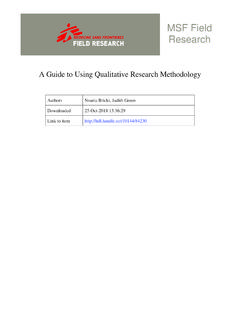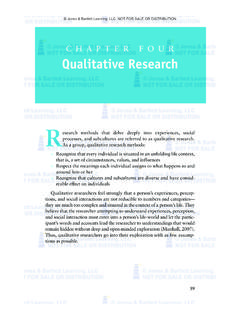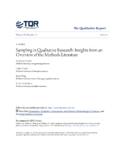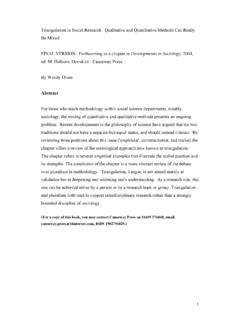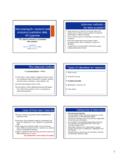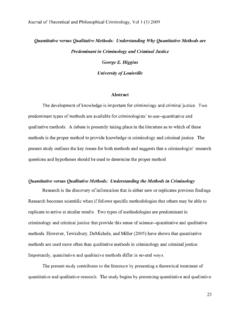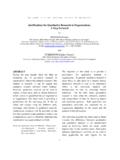Transcription of A Guide to Using Qualitative Research Methodology
1 A Guide to Using Qualitative Research Methodology MSF FieldResearchAuthorsNouria Bricki, Judith GreenDownloaded17-Apr-2018 22:28:19 Link to Guide to UsingQualitative Research Methodology 2002 Michael Quinn Patton and Michael CochranReproduced with kind permission of Michael Quinn PattonExecutive SummaryThis Guide to Using Qualitative Research Methodology is designed to help you think about all the steps you need to take to ensure that you produce a good quality piece of work. The Guide starts by telling you whatqualitative Methodology is and when to use it in the field (understand people s belief system, perspectives, experiences).
2 It also flags the most important ethicalissues that you will encounter (consent and confidentiality). The second part of the Guide tackles how you can concretely develop Qualitative Research designs; starting from clearly defining your Research question (one of the most important steps in your Research !), to how to develop a Research protocol; and finally giving you tips on the sampling methods which are available and how to use third part details how you can actually obtain the data - what methods can you use to get the information you want?
3 The three main methods (individual interviews, group interviews and observationalmethods) are explained, and the steps to build these different methods are outlined (How to do a topic Guide ? How to ask questions? How to develop interview skills and manage expectations? How to run group discussions? etc)Finally, the fourth chapter looks into how, once you have collected all the data, you can manage it and analyse it. For themanagement of data, a few practical issues are addressed, such as confidentiality and security, translation and recording.
4 The analysis section will give you clues as to how to use thematic or narrative analysis, what validation strategies you need to think of, what good practice guidelines you should follow, and whether or not to use a computer studies will be developed throughout the year and put on the open Guide to Using Qualitative Research MethodologyContents1. What is Qualitative Research ? Aims, uses and ethical issues a) What is Qualitative Research ? 2 b) When to use Qualitative methods 3 c) Ethical issues 52. How to develop Qualitative Research designs a) The Research question 7 b) The Research protocol 8 c) A word on sampling 93.
5 How to generate data (i) Individual interviews a) Interviews- what are they? 11 b) Topic guides 12 c) Asking questions 13 d) Interviewing skills 14 e) Managing expectations 15 (ii) Group interviews a) What is a group interview? 16 b) Advantages of group interviews 16 c) Practical issues 17 (iii) Contextual data a) Observations 20 b) Reports and other written data 21 c) Oral data 214. Data management and analysis (i) Practical issues Confidentiality and security issues 22 Translation 22 Recording/transcribing interviews 22 (ii) Analysis Thematic analysis of data 23 Narrative analysis 25 The use of computer software 28 1.
6 What is Qualitative Research ? Aims, uses and ethical issues(a) What is Qualitative Research ? Qualitative Research is characterised by its aims, which relate to understanding some aspect of social life, and its methods which (in general) generate words, rather than numbers, as data for analysis. For researchers more familiar with quan-titative methods, which aim to measure something (such as the percentage of people with a particular disease in acommunity, or the number of households owning a bed net), the aims and methods of Qualitative Research can seem imprecise.
7 Common criticisms include: samples are small and not necessarily representative of the broader population, so it is difficult to know how far we can generalise the results; the findings lack rigour; it is difficult to tell how far the findings are biased by the researcher s own opinions. However, for many Research projects, there are different sorts of questions that need answering, some requiring quantitative methods, and some requiring Qualitative methods. If the question is a Qualitative one, then the most appropriate andrigorous way of answering it is to use Qualitative methods.
8 For instance, if you want to lobby for better access to health care in an area where user fees have been introduced, you might first undertake a cross-sectional survey which will tell you that of your population does not have access to care. This is essentialinformation, but you might also have a number of other questions that the survey can t answer very well, such as: what are people s experiences of user fees? what other barriers exist to accessing health care?These can be addressed throughqualitative methods such as interviews or focus groups.
9 If the final report is to be used for lobbying, the quantitative data and Qualitative data together are very powerful. The survey identifies the extent of the problem, and the interviews can be used to give some of the detail, and the story of how user fees have affected situations where little is known, it is often better to start with qualitativemethods (interviews, focus groups, etc). It can help you with generating hypotheses that can then be tested by quantitative methods. For instance, in an area where we had no idea what kinds of issue were acting as barriers to health care, it would be difficult to design a survey to cover the main factors.
10 Once these have beenidentified, then a quantitative approach (such as a survey) can be used if you need Not everything that can be counted counts, and not everything that counts can be counted (Albert Einstein)23to measure to what extent these issues are typical for the whole first step in Research is, then, toidentify whether the specific researchquestion you want to answer is bestanswered by a quantitative or a Qualitative approach. Often, there are severalquestions that we need to answer, such as How many people are affected?
